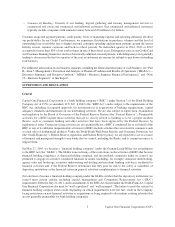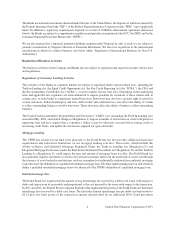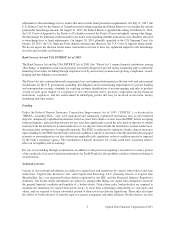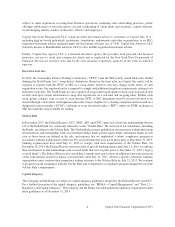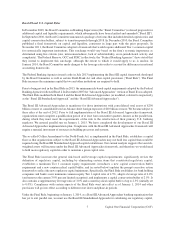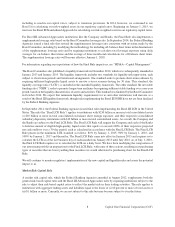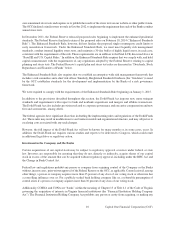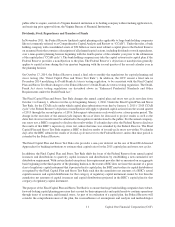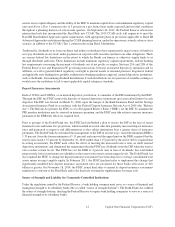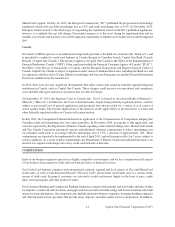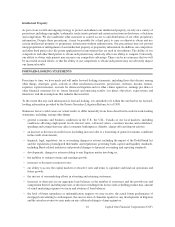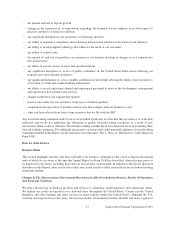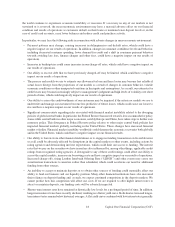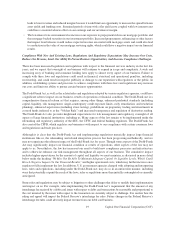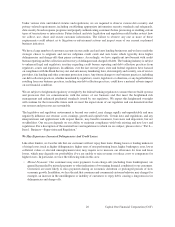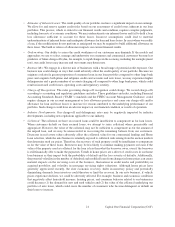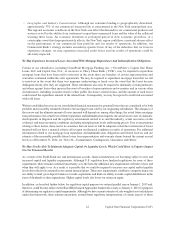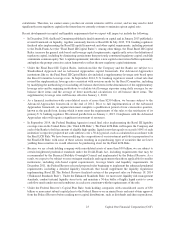Capital One 2014 Annual Report Download - page 35
Download and view the complete annual report
Please find page 35 of the 2014 Capital One annual report below. You can navigate through the pages in the report by either clicking on the pages listed below, or by using the keyword search tool below to find specific information within the annual report.Under the “cross-guarantee” provision of the Financial Institutions Reform, Recovery and Enforcement Act of 1989
(“FIRREA”), insured depository institutions such as the Banks may be liable to the FDIC with respect to any loss
incurred, or reasonably anticipated to be incurred, by the FDIC in connection with the default of, or FDIC assistance
to, any commonly controlled insured depository institution. The Banks are commonly controlled within the meaning
of the FIRREA cross-guarantee provision.
FDIC Orderly Liquidation Authority
The Dodd-Frank Act provides the FDIC with liquidation authority that may be used to liquidate nonbank financial
companies and bank holding companies if the Treasury Secretary, in consultation with the President and based
on the recommendation of the Federal Reserve and another federal agency, determines that doing so is necessary,
among other criteria, to mitigate serious adverse effects on U.S. financial stability. Upon such a determination,
the FDIC would be appointed receiver and must liquidate the company in a way that mitigates significant risks
to financial stability and minimizes moral hazard. The costs of a liquidation of a financial company would be
borne by shareholders and unsecured creditors and then, if necessary, by risk-based assessments on large financial
companies. The FDIC has issued rules implementing certain provisions of its liquidation authority and may issue
additional rules in the future.
Regulation of International Business by Non-U.S. Authorities
COBNA is subject to regulation in foreign jurisdictions where it operates, currently in the United Kingdom and
Canada.
United Kingdom
In the United Kingdom, COBNA operates through Capital One (Europe) plc (“COEP”), which was established in
2000 and is an authorized payment institution regulated by the Financial Conduct Authority (the “FCA”) under the
Payment Services Regulations 2009. COEP’s indirect parent, Capital One Global Corporation, is wholly-owned by
COBNA and is subject to regulation by the Federal Reserve as an “agreement corporation” under the Federal
Reserve’s Regulation K.
Over the past few years the U.K. government has enacted significant changes to the framework of financial services
regulation. As part of these changes, in April 2013, the Financial Services Authority (“FSA”) was split into a new
Prudential Regulatory Authority (“PRA”) and the FCA, with the FCA, rather than the PRA, regulating COEP. In
April 2014, the FCA took over regulation of the U.K. consumer credit regime previously regulated by the Office of
Fair Trading (the “OFT”). The FCA’s new regulatory purview includes credit card lending activities. The FCA
published a new Consumer Credit Sourcebook (“CONC”) which came into effect on April 1, 2014, with a six month
transitional period, which ended on September 30, 2014, for COEP and other card issuers already in compliance
with the existing OFT regime. The CONC replicates existing laws and guidance that COEP was subject to under
OFT regulation, although there are some amendments and new rules and guidance.
Regulatory focus on Payment Protection Insurance (“PPI”) complaint handling has continued as PPI continues to
be a key driver of consumer complaints to the Financial Ombudsman Service. COEP continues to deliver on its
remediation plan in relation to PPI complaints.
COEP is a party to the Card Protection Plan Limited (“CPP”) redress scheme which enables customers who bought
card protection insurance with CPP to seek compensation. In January 2014 the redress scheme was launched with
a general claims bar date of August 30, 2014, other than exceptional circumstances. The claims bar date for
exceptional circumstances is February 28, 2015.
On July 4, 2013, the European Court of Justice (“ECJ”) heard MasterCard’s appeal against the General Court’s
decision that its cross-border interchange fees were anti-competitive. In September 2014, the ECJ dismissed
13 Capital One Financial Corporation (COF)


